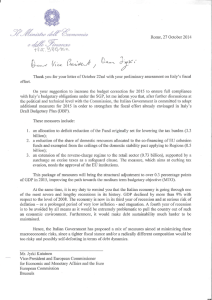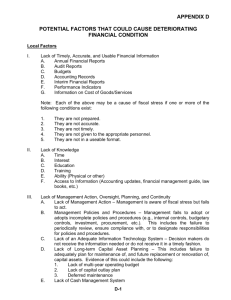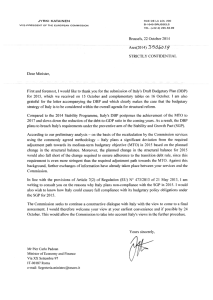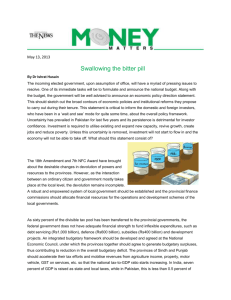Flexibility clauses in the Stability and Growth Pact: No Need for
advertisement
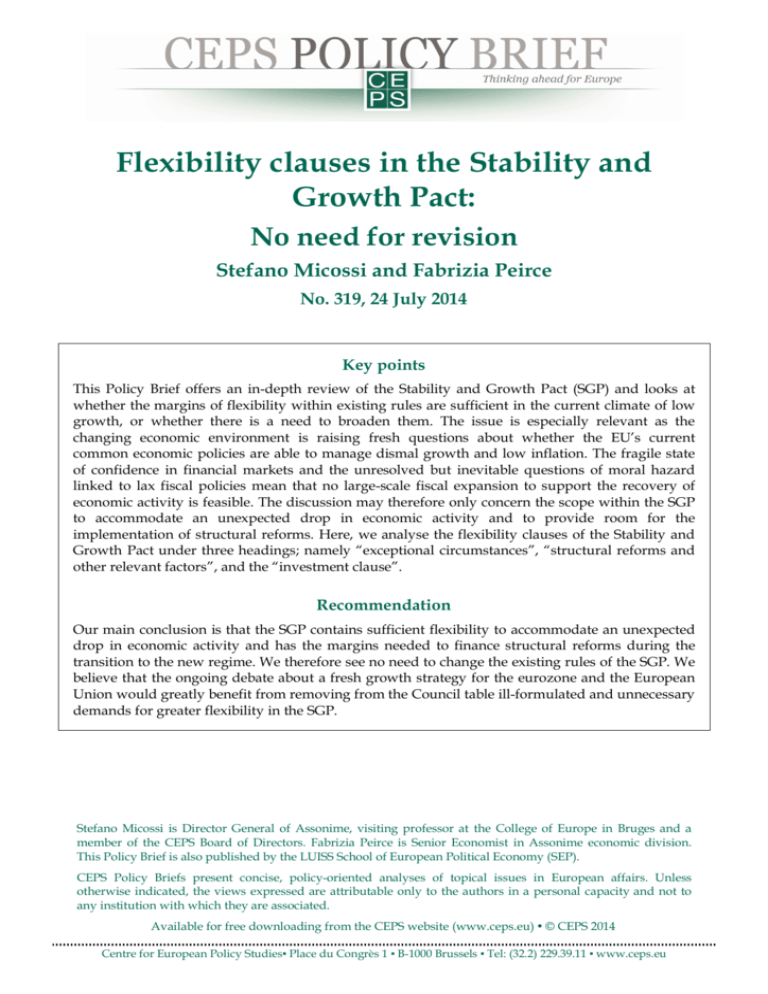
Flexibility clauses in the Stability and Growth Pact: No need for revision Stefano Micossi and Fabrizia Peirce No. 319, 24 July 2014 Key points This Policy Brief offers an in-depth review of the Stability and Growth Pact (SGP) and looks at whether the margins of flexibility within existing rules are sufficient in the current climate of low growth, or whether there is a need to broaden them. The issue is especially relevant as the changing economic environment is raising fresh questions about whether the EU’s current common economic policies are able to manage dismal growth and low inflation. The fragile state of confidence in financial markets and the unresolved but inevitable questions of moral hazard linked to lax fiscal policies mean that no large-scale fiscal expansion to support the recovery of economic activity is feasible. The discussion may therefore only concern the scope within the SGP to accommodate an unexpected drop in economic activity and to provide room for the implementation of structural reforms. Here, we analyse the flexibility clauses of the Stability and Growth Pact under three headings; namely “exceptional circumstances”, “structural reforms and other relevant factors”, and the “investment clause”. Recommendation Our main conclusion is that the SGP contains sufficient flexibility to accommodate an unexpected drop in economic activity and has the margins needed to finance structural reforms during the transition to the new regime. We therefore see no need to change the existing rules of the SGP. We believe that the ongoing debate about a fresh growth strategy for the eurozone and the European Union would greatly benefit from removing from the Council table ill-formulated and unnecessary demands for greater flexibility in the SGP. Stefano Micossi is Director General of Assonime, visiting professor at the College of Europe in Bruges and a member of the CEPS Board of Directors. Fabrizia Peirce is Senior Economist in Assonime economic division. This Policy Brief is also published by the LUISS School of European Political Economy (SEP). CEPS Policy Briefs present concise, policy-oriented analyses of topical issues in European affairs. Unless otherwise indicated, the views expressed are attributable only to the authors in a personal capacity and not to any institution with which they are associated. Available for free downloading from the CEPS website (www.ceps.eu) © CEPS 2014 Centre for European Policy Studies▪ Place du Congrès 1 ▪ B-1000 Brussels ▪ Tel: (32.2) 229.39.11 ▪ www.ceps.eu 2 | MICOSSI & PEIRCE Introduction The policy debate about how best to restore growth in the flagging eurozone economy has been plagued by demands from some highly indebted member countries that the Stability and Growth Pact (SGP) be loosened to leave greater room to support the economy with budgetary instruments. These demands have been met with an instant rebuff from the Commission and other financially solid members who argue that loosening the Pact would do little to restore sound growth. This question has also hindered the broader discussion on the need for and content of a renewed growth strategy for the eurozone and the European Union, no least by fuelling fresh mistrust among their member states. The lack of clarity about what precisely would be the scope of budgetary flexibility has not helped to resolve the issue. In one extreme interpretation, flexibility could mean removing altogether the budgetary constraint on highly indebted countries and letting them support the economy with deficit spending and tax cuts. The argument is that budgetary austerity was the main culprit in pushing the eurozone economy into its double-dip recession in 2010-12, and that growth could therefore be restored by relaxing budgetary constraint. Two observations are in order in this regard. The IMF (2012) and Blanchard and Leigh (2013), among others, have argued that fiscal retrenchment in 2010-11 led to a fall in economic activity well above forecasts, indicating that fiscal multipliers had been largely underestimated. What this analysis may be overlooking is the major role played in the drop in economic activity by the sharp contraction of bank credit, owing in turn to the collapse of net private foreign financing to countries under stress, as depicted in Figure 1.1 The drying up of interbank lending was the main component in this reduction of foreign inflows, and was led by evaporating confidence in the banking system of the eurozone periphery, in turn due to their Ireland is not included due to lack of comparable Eurostat data. 1 heavy exposure to national sovereigns.2 The ECB compensated the collapse of private flows only partially and temporarily through its Target-Two balances, but this did not prevent the drop in economic activity throughout the periphery. Nothing comparable happened after the Lehman Brothers collapse, when net foreign inflows continued – presumably thanks to the absence at that time of visible disagreement on policy responses among the eurozone members. This brings us to our second observation. While confidence has now been somewhat restored to eurozone financial markets, thanks to a combination of budgetary retrenchment by indebted countries and liquidity support from the ECB, the situation remains fragile, as shown by the shock-waves generated by the difficulties of the Portuguese Banco Espírito Santo in mid-July. In all likelihood any large-scale relaxation of the budgetary constraint in highly indebted countries would soon encounter a flight of investors. Of course, this could be avoided by letting the ECB purchase the sovereigns of highly indebted countries or convincing the core countries to guarantee the debts of the periphery: unfortunately, moral hazard considerations would exclude any such possibility in practice, as the required agreement by the main policy actors would never be achieved. IMF econometric estimates on multipliers – while taking into account many other potentially relevant factors – do not control directly for the collapse of net foreign financial flows. The key role of the “sudden stop” of net private foreign financing in bringing about the eurozone crisis has been seen as mainly depending on the eurozone’s peculiar institutional structure, which raised doubts in financial markets about the availability of liquidity support by the ECB for the orderly rollover of distressed sovereign exposure (De Grauwe 2011, De Grauwe & Ji 2013, and Merler & Pisani-Ferry 2012). The confidence crisis was exacerbated by the announcement in Deauville (October 2010), and then the application in the second Greek package (summer 2011), of a new policy of private sector participation in sovereign debt restructuring, which triggered the contagion of the sovereign debt and banking crisis to Spain and Italy. 2 FLEXIBILITY CLAUSES IN THE STABILITY AND GROWTH PACT: NO NEED FOR REVISION | 3 Figure 1. The collapse of net foreign financing in the ‘PIGS’ in 2011-2012 Source: Eurostat 2014. The ‘PIGS’ include: Portugal, Italy, Spain and Greece. In sum, any large-scale relaxation of budgetary constraint, with the main purpose of supporting economic activity, cannot be considered seriously. To be sure, this does not obviate the potential need for the eurozone to act with common policy instruments to strengthen the economic recovery, including a more aggressive use of monetary instruments (as argued by the IMF in 2014), a joint initiative to raise public and private investment (Bassanini & Reviglio, 2014), and possibly also a scheme to directly address the question of debt sustainability (as in Pâris & Wyplosz, 2014). But there is broad consensus that these actions must be discussed and brought forward without endangering the results achieved under fiscal consolidation. This seems to be the conclusion reached by the European Council at their recent meeting in June 2014: “ ... fiscal consolidation must continue in a growth-friendly and differentiated manner. Structural reforms that enhance growth and improve fiscal sustainability should be given particular attention [...] while making best use of the flexibility that is built into the existing Stability and Growth Pact rules”. They are not excluding a change in the general direction of economic policies, but they do not consider that this can be achieved by relaxing the rules of the SGP. It follows that the discussion about flexibility within the SGP must have a more limited scope, which is how much room is available within existing rules for two different goals: to cushion an unexpected fall in activity through the operation of budgetary stabilisers, and to accommodate structural reforms capable of strengthening the economy and the budget itself in the long run, but requiring some budgetary flexibility in the short run to meet their initial cost (e.g. in the transition to fully funded pension systems or a flexi-security model of unemployment support). The purpose of this paper is to offer a detailed review of the SGP and to discuss whether the existing margins of flexibility are adequate to meet those two separate goals. The matter mainly arises with regard 4 | MICOSSI & PEIRCE to countries that have not undertaken an adjustment programme under the aegis of the Commission (or the Troika), but may also affect countries in excessive deficit procedure (EDP). For countries undertaking an adjustment programme under Commission control, all fiscal requirements are specified and enforced in that context. The structure of this Brief is as follows. Section 1 provides an overview of the SGP’s evolution since the Maastricht Treaty. We then analyse the flexibility clauses of the SGP under three headings, i.e. “exceptional circumstances” (section 2), “structural reforms and other relevant factors” (section 3) and the “investment clause” (section 4). Section 5 concludes. 1. An overview of the SGP In establishing the Economic and Monetary Union (EMU), the Maastricht Treaty introduced a number of legal provisions disciplining member states’ fiscal policies, notably including the prohibition of monetary financing of deficits by the ECB or national central banks (Article 123, TFEU), the no-bail-out clause (Article 125, TFEU) and the excessive deficit procedure (EDP, Article 126 TFEU). The criteria for the “soundness and sustainability” of public finances were set to coincide with the convergence criteria for admission to EMU – 3% for the deficit-toGDP ratio and 60% for the debt-to-GDP ratio – and were enshrined in Protocol 12 annexed to the Treaty. The Maastricht Treaty also provided procedures for the coordination (convergence) and surveillance of national economic policies (under the Broad Economic Policies Guidelines, or BEGP, of Article 121, TFEU) and specifically for employment polices (Article 148, TFEU). Two Council Regulations set up the SGP with the specific purposes of ensuring compliance with the Treaty’s fiscal rules after inception of EMU (Regulation 1466/97, the ‘preventive arm’ of the SGP under Article 121, TFEU) and setting out the implementing procedure of the EDP (Regulation 1467/97, the ‘corrective arm’ of the SGP under Article 126, TFEU). The coercive provisions on excessive deficits and the adoption of the BEGP would not apply to countries not participating in the common currency (countries “with a derogation”, Article 139, TFEU) until they joined the euro, nor to the UK (Protocol 15) or Denmark (Protocol 16). The need for common fiscal rules arose from the peculiar institutional structure of EMU – with a common currency and common monetary policy but decentralised fiscal policies, which could allow lax budgetary policies to threaten the smooth functioning of EMU by feeding persistent inflation divergence among its members and allowing an unsustainable accumulation of sovereign debts. A prescient further justification was the fear that EMU might loosen the borrowing constraint on its members’ government budget as risk premia would no longer reflect expectations of exchange rate depreciation and other borrower-specific risks. Similar policies, albeit somewhat less constraining, were also adopted by EU members not participating in the eurozone. In the original formulation, stability (for eurozone members) or convergence (for noneurozone) programmes would have to include a medium-term budgetary position (MTO) “close to balance or in surplus”, together with an adjustment path towards this objective, and the expected path of the general government debt ratio.3 The SGP was subsequently modified twice. In 2005, the goal was to make it more flexible, following repeated violations of the deficit rules earlier in the decade in a phase of pronounced economic slowdown, 4 and the controversial decision by the Ecofin Council 3 Article 3.2(a) of Regulation 1466/1997. Six euro area member states incurred excessive deficits since 1999: Portugal in 2001 (and again in 2005), Germany and France in 2002, the Netherlands and Greece in 2003, and Italy in 2004. Only the Netherlands succeeded in correcting its excessive deficit in a durable manner. Some countries increasingly resorted to temporary measures to comply with the rules. In an interview to Le Monde (2002), Commission President Prodi famously dubbed the Pact as “stupid” for trying to stick to the 3% rule without taking into account current economic conditions. Cf. also De Grauwe (2005). 4 FLEXIBILITY CLAUSES IN THE STABILITY AND GROWTH PACT: NO NEED FOR REVISION | 5 in November 2003 to put in abeyance the excessive deficit procedure for France and Germany. 5 Three changes were introduced: that the MTO should be country specific; that it should be set for each country in structural terms, that is cyclically adjusted and net of one-off and temporary measures; and that it would take into account the member states' (gross) public debt level and the fiscal challenges posed by ageing. 6 Moreover, it was decided that the EDP deadlines for corrective actions could be extended for countries that had taken effective corrective action but were faced with “unexpected adverse economic events with major unfavourable consequences on public finances”.7 However, an important new provision required that national budgets would have in all circumstances to respect the 3% deficit ratio, even in the presence of revenue shortfalls due to adverse cyclical developments. To this end, countries were expected to undertake a stronger adjustment effort in good times so as to have more latitude for the operation of budgetary stabilisers in downturns.8 In 2011 the SGP was amended again, with the so-called Six Pack legislation, 9 this time to correct its perceived inability to prevent the build-up of unsustainable fiscal imbalances that were seen as an important determinant of the eurozone crisis. Both the preventive and the corrective arm of the Pact were strengthened to ensure the early recognition of emerging imbalances, to bring forward corrective actions and reinforce the sanctioning apparatus. The new rules include constraints on the growth of public expenditures and an operational criterion for the correction of debt/GDP ratios in excess of the 60% benchmark. 10 Furthermore, Commission proposals on the enforcement of the SGP may only be rejected by the Council by qualified majority, except for the decision on the final stage of sanctions in the SGP corrective arm – a shift of power designed to strengthen the credibility of the SGP after past failures to act by the Council.11 Finally, in 2013 surveillance under the SGP was completed by the adoption of the socalled Two Pack12 and the entry into force of the Fiscal Compact. 13 Under the Two Pack, eurozone members are required to submit their draft budgets to the European Commission before they are adopted by national parliaments, and the Commission may ask for revisions if it considers that the draft breaches or is likely to breach the SGP. Expenditure growth should not exceed a reference medium-term rate of potential GDP growth, unless the excess is matched by discretionary revenue measures (Article 1.8 of Regulation 1175/2011); and revenue windfalls should be allocated to deficit or debt reduction (whereas 18 of Regulation 1175/2011). The 1/20th criterion requires member states whose debt exceeds 60% of GDP to reduce the distance between the actual ratio and the 60% benchmark each year by 1/20th of the distance (Article 1.2 of Regulation 1177/2011). 10 Cf. Regulation 1173/2011. Simple majority in the Council is also sufficient to reject a Commission recommendation to adopt a decision establishing that no effective action has been taken to correct a divergence from the MTO (Article 1.13 of Regulation 1175/2011). 11 2546th Council meeting - Economic and Financial Affairs - Brussels, 25 November 2003C/03/320 14492/1/03 (Presse 320). 5 Article 1.1 of Regulation No1055/2005. Cf. also Economic and Financial Committee (2012), Section I. 6 7 Article 1.5 of Regulation No 1056/2005. Article 1.3(a) of Regulation No 1055/2005. See also High Level Group chaired by Wim Kok (2004). 8 Regulation No 1175/2011 (preventive arm of SGP); Regulation No 1177/2011 (corrective arm of SGP); Regulation No 1173/2011 (‘sanction regulation’); Council Directive 2011/85/EU (requirements for budgetary frameworks); Regulation No 1176/2011 (‘macroeconomic imbalances procedure’); Regulation No 1174/2011 (sanctions under macroeconomic imbalances procedure). 9 Regulation No 473/2013 on common provisions for monitoring and assessing draft budgetary plans and ensuring the correction of excessive deficit of the euro area member states (Two Pack I) and Regulation No 472/2013 on the strengthening of economic and budgetary surveillance of member states in the euro area experiencing or threatened with serious difficulties with respect to their financial stability (Two Pack II). 12 The Treaty on Stability, Coordination and Governance in the Economic and Monetary Union (TSCG). 13 6 | MICOSSI & PEIRCE Eurozone countries in EDP will be required to present an “economic partnership programme” providing a roadmap for the structural reforms seen as instrumental to “an effective and lasting correction” of the excessive deficit.14 Under the Fiscal Compact eurozone members (and other EU members voluntarily joining the Treaty as “contracting parties”) committed to adopt binding rules – preferably constitutional – for balanced budgets, including the automatic corrective mechanism in case of significant deviations from the MTO. 15 Main changes in the SGP since its adoption are summarised in tables 1 and 2.16 Finally, the European Semester brings national policymaking coordination together under the procedure of Article 121 TFEU, ensuring ex ante coordination of economic policy decisions by the member states within the European Council. Under the European Semester, the Council issues its countryspecific recommendations for national policies and the eurozone as a whole at the end of the first semester, based on national stability (budgetary) and economic-reform programmes submitted in April; the member states then adopt their national budgets and policy programmes in the second semester under close (ex ante) surveillance by the European Commission.17 2. Exceptional circumstances The concept of “exceptional circumstances” appears in Article 126.2 (a) of the Treaty where it is stated that the EDP would not be triggered even if the reference value of the deficit ratio (3%) had been breached, when the excess over the reference value “is only exceptional and temporary and the ratio remains close to the reference value”. The definition of “exceptional circumstances” is provided by the Council Regulation 1467/97 14 15 Articles 4, 7 and 9 of Regulation 473/2013. Article 3 of TSCG. For a comprehensive discussion on the SGP see Frayne et al. (2013) and Frayne and Riso (2013). 16 17 Article 1.3 of Regulation 1175/2011. as amended by Regulations 1056/2005 and 1177/2011 (henceforth in this paper Regulation 1467 – i.e. ‘the corrective arm’ of the SGP)18 – as an unusual event outside the control of the member state which has a major impact on its financial position or a severe economic downturn (Article 2.1). The text further specifies that any excess over the reference value shall be considered as temporary if the forecasts provided by the Commission indicate that the deficit will fall below the reference value following the end of the unusual event. In the original SGP, an economic downturn was qualified as “severe” when annual real GDP had fallen by at least 2%. A fall of less than 2% could also be considered exceptional in the light of further supporting evidence, in particular on the abruptness of the downturn or on the accumulated loss of output relative to past trends.19 In 2005, the benchmark for identifying a severe economic downturn was eased: the reference to a 2% decline in GDP was suppressed and it became sufficient to show that there had been a decline in (annual real) GDP or an accumulated loss of output during a protracted period of very low annual real GDP growth relative to potential gauged from the output gap – which is obviously applicable to current economic conditions.20 It should be stressed that an excess over the deficit reference value “may” be considered as exceptional by the Commission and the Council in light of various circumstances: this formulation excludes any automatism in deciding that the member state in question is indeed facing exceptional circumstances. Similarly, when a member state is already subject to an EDP, the Commission and the Council may issue revised recommendations granting longer deadlines (one more year as a (http://eurlex.europa.eu/LexUriServ/LexUriServ. do?uri=CONSLEG:1997R1467:20111213:EN:PDF). 18 19 Cf. Article 2.2 and 2.3 of Regulation 1467/1997. Article 2.2 Regulation 1467. The indicator for assessing the accumulated loss of output, based on the output gap, is calculated according to the method agreed by the Ecofin Council on 12 July 2002. 20 FLEXIBILITY CLAUSES IN THE STABILITY AND GROWTH PACT: NO NEED FOR REVISION | 7 rule) to meet their deficit targets when weak economic outcomes hamper their ability to achieve them despite serious consolidation efforts.21 The original SGP provided for the correction of an excessive deficit to be completed “in the year following its identification unless there are special circumstances”, but did not specify what these “special circumstances” might be. Following the reform, the initial deadline for correcting an excessive deficit should remain, as a rule, the “year after identification”. However, the setting of this deadline and consideration as to whether there are special circumstances justifying an extension by one year should be based on a balanced overall assessment of exceptional circumstances, together with other mitigating and aggravating factors. We return to these factors (dealt with by Article 2.3 of Regulation 1467) later. Exceptional economic circumstances can also justify the reduction or abrogation of sanctions imposed on member states in the event of particularly serious non-compliance with budgetary policy obligations in the EDP.22 In 2013 a number of countries, including France, had their EDP deadlines extended and the intensity of the effort required softened under these provisions. The Six Pack of 2011 made allowance for consideration of exceptional circumstances, also in the preventive arm of the SGP: under the Council Regulation 1466/97 as amended by Regulations 1055/2005 and 1175/2011 (henceforth in this paper Regulation 1466)23 they can be taken into consideration by the Commission and the Council to allow a temporary deviation from the adjustment path towards the MTO, on condition that this does not endanger fiscal sustainability in the medium term.24 Resort to this provision was granted to Italy by the Council in 2013, making it possible for that country to postpone achievement of structural balance following a sharp downturn of economic activity, but has been denied in 2014.25 3. Structural reforms and the other relevant factors The preventive arm of SGP allows for important elements of flexibility in defining the adjustment path towards the MTO or consenting member states to deviate temporarily from it, most notably the effective implementation of structural reforms capable of underpinning financial stability by strengthening the economy and raising potential growth.26 The Specifications on the implementation of the SGP (the socalled Code of Conduct) stress that only “adopted reforms” will be considered for this purpose. 27 Moreover, here too a safety margin with respect to the 3% deficit reference value must be guaranteed at all times, 28 and the budgetary position must return to the MTO within the three-year period covered by the Stability Programme. The rationale is that structural reforms may bring about long-term expenditure cuts and revenue increases, e.g. stemming from improved sustainability of the health and pension system or reduced long-term unemployment following labour market reform, even if they may entail short-term costs for public finances. And indeed the Code of Conduct explicitly mentions structural reform in these areas as factors permitting temporary deviations from the MTO. Special consideration will be given to “pension reforms introducing multi-pillar systems that include a mandatory, fully Cf. The Council 2014 Country Recommendations on Italy (10791/14). 25 Specific 26 21 Article 3.5 of Regulation 1467. Article 5.1 Regulation 1466. 27 22 Article 6.4 of Regulation 1173/2011. Economic and Financial Committee (2012), p. 7. 28 (http://eurlex.europa.eu/LexUriServ/LexUriServ. do?uri=CONSLEG:1997R1466:20111213:EN:PDF). 23 Articles 5.1 par. 10 and 6.3 par. 4 of Regulation 1466. 24 This safety margin will be evaluated by the Commission taking into account past output volatility and the budgetary sensitivity of output fluctuations. Cf. the Code of Conduct, Economic and Financial Committee (2012). 8 | MICOSSI & PEIRCE funded pillar”. In this case the permitted deviation from the MTO should reflect the net cost of the reform for the general government budget,29 and always providing that the safety margin for deficit ratio is preserved.30 Due consideration to pension reform will also be given by the Council and the Commission when assessing compliance with the deficit and debt criterion and in the subsequent steps of the EDP procedure. In particular, a broader assessment on the overall features of the pension system created by the reform will verify whether it promotes long-term sustainability while not increasing risks for the medium-term budgetary position.31 According to Article 126.3 of the Treaty, the European Commission is always required to prepare a report to the Council when it finds that the government deficit and/or debt ratios exceed the reference values and are not diminishing at a satisfactory pace. In this report, which constitutes the first step of an EDP, the Commission must take into account whether the deficit exceeds investment expenditure and “all other relevant factors, including the medium-term economic and budgetary position of the member state”. In this regard, Article 2.3 of Regulation 1467 specifies that the Commission report must cover all relevant medium-term developments regarding: a. the economic position, including potential growth, the different contributions In evaluating the cost of the reform, only annual incremental increases in that cost will be considered. 29 The costs of pension reforms covered by the clause are those linked to diverting part of social security contributions to the pension scheme established by the reform, which entails a permanent reduction of revenues and in the short term worsens the government balance. However, over the long run, such costs are compensated by the reduction in pension expenditure to be paid by the public scheme. The first application of the provision on pension reform arose in 2013 with Latvia. 30 Article 2.5 of Regulation 1467. Under EDP the full costs of the reform are considered every year and not only their incremental increase as under the preventive arm. 31 provided by labour, capital accumulation and total factor productivity, cyclical developments and the private sector net saving position; b. the budgetary position, and notably the record of adjustment towards the MTO, the level of the primary balance and developments in primary expenditure, both current and capital, and the overall quality of public finances; c. the debt position, its dynamics and sustainability, including any implicit liabilities related to ageing and private debt, to the extent that it may represent a contingent implicit liability for the government. Furthermore, due consideration will be given to any other factors which, in the opinion of the member state concerned, are relevant in order to comprehensively assess compliance with the deficit and debt criteria. 32 For instance, in 2011 the Italian government argued that the sum of the net public and private debt positions should also be taken into consideration when assessing a member’s financial conditions and their sustainability. An objection raised against this concept was that there is no guarantee that domestic investors will behave differently from foreign investors when confidence in the sovereign’s solvency evaporates. Under certain conditions, consideration of “relevant factors” may lead to not placing a member state in EDP, e.g. when the deficit ratio has been exceeded but the debt ratio is below the reference value. Similarly, a breach of the debt reduction benchmark may result in the opening of an EDP only after relevant factors have been taken into account; similarly, these factors will be considered in To this end, special consideration will be given to: “budgetary efforts towards increasing or maintaining at a high level financial contributions to fostering international solidarity and to achieving Union policy goals; the debt incurred in the form of bilateral and multilateral support between member states in the context of safeguarding financial stability; the debt related to financial stabilisation operations during major financial disturbances”. 32 FLEXIBILITY CLAUSES IN THE STABILITY AND GROWTH PACT: NO NEED FOR REVISION | 9 the recommendations for correcting the excessive deficit, including the deficit reduction path. 4. The investment clause During the crisis, activity fell more rapidly than expected in countries undertaking tough adjustment programmes to restore sustainable budgetary and competitive positions, also dragging down the ‘core’ economies and pushing the entire eurozone into recession. Unfortunately, the easiest target of fiscal consolidation was public investment, which fell dramatically in the crisis years.33 In its Blueprint for a deep and a genuine EMU, 34 the European Commission summarised the few specific provisions for public investment already provided for in the SGP. Public investment is one of the factors to be taken into account in the EDP when assessing the fiscal position of a member state (Article 126.3 TFEU).35 In the preventive arm of the SGP, in assessing the public expenditure growth path, public investment is averaged over a number of years, so as to avoid penalising member states experiencing temporary peaks in investment. Expenditure on Union programmes, including investment expenditure, is also excluded in assessing compliance with the expenditure benchmark, for the part covered by EU funds. Of course, none of these provisions prevented a sharp drop in public investment, as has been recalled, but this was member states’ choice rather than a result of SGP rules. In June 2012 and again in March 2013, the European Council recognised in their conclusions the need to “balance the productive public investment needs with fiscal discipline objectives”; 36 thus opening 33 Cf. Barbiero & Darvass (2014). 34 European Commission (2012). Specifically, Article 126(3) states that: "The report of the Commission shall also take into account whether the government deficit exceeds government investment expenditure (…)". 35 Council Conclusions, 13-14 June 2012 p. 1 and 14/15 March 2013 p.2. the door to a specific investment allowance in the SGP preventive arm that would relax MTO deficit convergence obligation while still respecting the 3% constraint. This intention was transformed into a legal provision in the Two Pack37 that requires the Commission to report to the Council on this issue by 31 July 2013. Accordingly, on 3 July 2013 Commissioner Olli Rehn sent a letter to the member states to clarify the statement in the Blueprint, stating that the Commission would allow temporary deviations from the structural deficit path towards the MTO, or from the MTO for member states that have reached it, provided that three conditions were met: 1) economic growth is negative or well below its potential; 2) the deviation does not lead to a breach of the 3% deficit ceiling and the public debt rule is respected; 3) the deviation from the MTO is linked to national expenditures on projects cofunded by the EU under its Structural and Cohesion policy, Trans-European Networks and Connecting Europe Facility. The Commission has also clarified that this investment clause should not be confused with the proposals to exclude growthenhancing investment from the deficit ceiling (the so-called golden rule of public finance), which does not worsen the debt time-path only when the total (economic and financial) return to those investments fully covers their cost. The problem here is that the notion of public investment and the calculation of returns is ill-defined and exposed to manipulation by opportunistic politicians (Balassone & Franco, 2001), possibly opening the gates to the excessive growth in government debt that the SGP was meant to avoid. The investment clause was to apply only as long as the current depressed economic conditions continue. Once the economy recovers any deviation from the MTO must 36 37 Article 16.2 of Regulation 473/2013. 10 | MICOSSI & PEIRCE be compensated for, thus ensuring that the time-path towards the MTO is not affected. In his letter mentioned above, Commissioner Rehn announced that the rule would be applicable when assessing 2014 national budgets and the budgetary outcomes for 2013. The Commission, however, has remained staunchly opposed to using this clause and managed to reject Italy’s request to use it in autumn 2013 on the grounds that the country was not compliant with the debtratio reduction path. 5. Conclusions Our review of the SGP indicates that there is no need to revise the existing rules to introduce greater flexibility during the current depressed economic conditions.38 First, the SGP has ample room to accommodate the need for countering cyclical oscillations in the economy through the operation of budgetary stabilisers. This is obviously true for countries respecting the budgetary MTO of “close to balance or in surplus” – the MTO is calculated on a “structural” basis so they would be able to fully exploit the 3% margin for the deficit ratio. But it also applies to countries still working to achieve their MTO, provided they do not exceed the 3% threshold, as well as to countries in EDP, under the “exceptional circumstances” clause. It should be stressed here that the 3% limit is not an unassailable wall, since countries may well decide to break it and enter the EDP when they feel that this is absolutely necessary in view of economic circumstances. Indeed, the EDP is also sufficiently flexible to accommodate such special needs. Of course, scrutiny by the Commission is tightened whenever the MTO Cf. Tosato (2014), who stresses that: i) the rigidity of the rules is mitigated by adequate flexibility in their application; ii) their application always involves the continuing participation of national budgetary authorities, with the twofold purpose of ensuring their ‘ownerhip’ of policy recommendations and, at the same time, making it possible for national authorities to shape concrete measures with full appreciation of national specificities. 38 is not respected, and even more when a country crosses the 3% threshold, but this is a natural consequence of the need to avoid undesirable spillovers on financial stability of the eurozone as a whole. As for the investment clause, it appears that its potential role in creating room for growthenhancing public spending has been overemphasised, for the twofold reason that all spending in the end adds to the debt dynamics and that investment spending when the public budget is out of order rarely is for real investment. It has been argued that this latter problem would be less serious if the investment projects were those approved by the Commission for the utilisation of structural funds, thus ensuring their proper quality. However, in this case there would be a better way to raise the room for public investment that would not impinge on the deficit ratio, i.e. to lower the matching fund requirement for the utilisation of structural funds, say from 50 to 25%. The same conclusion applies, a fortiori, for deviations from the MTO to accommodate the short-term costs of structural reforms, both as regards the deficit and the debt ratios. Indeed, in its preventive arm the SGP pays great attention to the need to accompany member states undertaking ambitious reform with larger budgetary margins during the transition to the new regime; the tight constraint to be respected is that these reforms must be ‘adopted’ and not simply announced. Of particular importance is the allowance made by the SGP for assessing flexibly the adjustment path of the debt ratio to GDP – in view of “its dynamics and sustainability” – in the presence of structural reform that credibly improves the debt timepath in the medium- to-long term. In sum, SGP rules already contain the flexibility required to accommodate cyclical downswings in the economy and structural reforms, while there can be no lasting benefits from relaxing its constraints. These could slow budgetary consolidation and once more raise the prospect of financial instability in the entire eurozone. FLEXIBILITY CLAUSES IN THE STABILITY AND GROWTH PACT: NO NEED FOR REVISION | 11 Table 1. THE EVOLUTION OF THE STABILITY AND GROWTH PACT: PREVENTIVE ARM 1997 SGP Objective MTO close to balance or in surplus 2005 SGP Country specific MTO in structural terms Safety margin against the 3% deficit/GDP limit Room for budgetary manoeuvre MTO> -1% of GDP Ex-ante assessment of progress towards the MTO 2011-2013 SGP Adjustment path Temporary from MTO deviation - - Annual adjustment: benchmark of +0.5% of GDP (structural terms) more in good times, less in bad times Possible for ‘major’ structural reforms with verifiable impact on long-term (emphasis on pensions reform) Enforcement - - Expenditure benchmark: expenditure growth net of discretionary revenue measures not exceed a reference medium-term rate of potential GDP growth MTO >-0.5% of GDP unless debt significantly below 60% of GDP and low risk for sustainability (TSCG) Ex-ante monitoring of MS budgetary policies (EZ only): common budgetary timeline to monitor and share information on MS budgetary policies before their adoption Possibility for Commission to require a revised draft budgetary in case of serious non-compliance with the SGP (Two-Pack I) >0.5% of GDP when debt >60% of GDP or risk of overall debt sustainability Automatic correction mechanism in national legal order monitored by independent national institutions (TSCG) In case of unusual events outside the control of the MS with a major impact on the financial position of the general government In case of severe economic downturn Procedure for correcting significant deviation (0.5% of GDP in one year or cumulatively over 2 years from MTO or the adjustment path towards it) Sanction in case of repeated non compliance (interestbearing deposit of 0.2% of GDP), EZ only, reversed QMV 12 | MICOSSI & PEIRCE Table 2. THE EVOLUTION OF THE STABILITY AND GROWTH PACT: CORRECTIVE ARM 1997 SGP Objective 2005 SGP To correct excess over the references values: Deficit : 3%of GDP Debt: 60% of GDP, or sufficiently diminishing 2011-2013 SGP New operational criterion for the evaluation of the public debt reduction towards the 60% of GDP threshold (‘1/20 rule’) Assessment The EDP will take account of ‘all’ relevant factors (mitigating/aggravating), such as private sector debt, (pension) implicit liabilities, ageing For countries under an EDP, increasing scope and frequency of information to be submitted to the Commission and to the Council for their review (Two Pack I): Graduated monitoring including regular reporting by the MS every 6 or 3 months, according to the stage of the procedure, to early detect a risk for not correcting MS’s excessive deficit by the set deadline. The Commission may issue a recommendation to the MS to take further or different action EZ MS entering EDP required to draft economic partnership programmes for structural reforms for the effective and lasting correction of the excessive deficit Adjustment path - Annual adjustment: at least +0.5% of GDP (structural terms) Possible deadline extension - If effective corrective action has been taken and In case of unusual events outside the control of the MS with a major impact on the financial position of the general government Enforcement Sanctions at the end of the procedure in case of nocompliance with Council decisions In case of severe economic downturn Early and gradual sanction system to be activated at each stage of the EDP (reversed QMV, except for latest stage of sanctions) Source: all relevant legal text for SGP and Fraine et al (2013). Note: MS: member states EZ: Eurozone member states, QMV qualified majority voting. FLEXIBILITY CLAUSES IN THE STABILITY AND GROWTH PACT: NO NEED FOR REVISION | 13 References Balassone, F. and D. Franco (2001), “EMU Fiscal Rules: a New Answer to an Old Question?”, in Fiscal Rules, Banca d’Italia, Rome. Barbiero, F. and Z. Darvas (2014), “In sickness and in health: protecting and supporting public investment in Europe”, Bruegel Policy Contribution 2014/02 February. Bassanini, F. and E. Reviglio (2014), “Long-term investment in Europe The origin of the subject and future prospects”, Astrid, Rassegna, No. 11/2014, 13 June. Blanchard, O. and D. Leigh (2013), “Growth Forecast Errors and Fiscal Multipliers”, IMF Working Paper No. 1/2013, January. Council of the European Union (2011), Regulation (EU) No 1177/2011 of 8 November 2011 amending Regulation (EC) No 1467/97 on speeding up and clarifying the implementation of the excessive deficit procedure. Council of the European Union (2011), Directive 2011/85/EU of 8 November 2011 on requirements for budgetary frameworks of the Member States. Council of the European Community (2005), Regulation (EC) No 1056/2005 of 27 June 2005 amending Regulation (EC) No 1467/97 on speeding up and clarifying the implementation of the excessive deficit procedure. Council of the European Community (2005), Regulation (EC) No 1055/2005 of 27 June 2005 amending Regulation (EC) No 1466/97 on the strengthening of the surveillance of budgetary positions and the surveillance and coordination of economic policies. Council of the European Community (1997), Regulation (EC) No 1467/97 on speeding up and clarifying the implementation of the excessive deficit procedure. Council of the European Community (1997), Regulation (EC) No 1466/97 on the strengthening of the surveillance of budgetary positions and the surveillance and coordination of economic policies. De Grauwe, P. (2011), “Governance of a Fragile Eurozone”, CEPS Working Document No. 346, Centre for European Policy Studies, Brussels, 4 May. De Grauwe, P. (2005), Economics of the Monetary Union, Oxford: Oxford University Press. De Grauwe, P. and Y. Ji (2013), “More evidence that financial markets imposed excessive austerity in the Eurozone”, CEPS Commentary, Centre for European Policy Studies, Brussels, 5 February. Economic and Financial Committee (2012), Specifications on the implementation of the Stability and Growth Pact and guidelines on the format and content of stability and convergence programmes, 3 September. European Commission (2012), The Blueprint for a deep and genuine Economic and Monetary Union, November. European Parliament and the Council of the European Union (2013), Regulation (EU) No 473/2013 of the Council of 21 May 2013 on common provisions for monitoring and assessing draft budgetary plans and ensuring the correction of excessive deficit of the Member States in the euro area. European Parliament and the Council of the European Union (2013), Regulation (EU) No 472/2013 of 21 May 2013 on the strengthening of economic and budgetary surveillance of Member States in the euro area experiencing or threatened with serious difficulties with respect to their financial stability. 14 | MICOSSI & PEIRCE European Parliament and the Council of the European Union (2011), Regulation (EU) No 1175/2011 of 16 November 2011 amending Council Regulation (EC) No 1466/97 on the strengthening of the surveillance of budgetary positions and the surveillance and coordination of economic policies. European Parliament and the Council of the European Union (2011), Regulation (EU) No 1173/2011 of 16 November 2011 on the effective enforcement of budgetary surveillance in the euro area. European Parliament and the Council of the European Union (2011), Regulation (EU) No 1176/2011 of 16 November 2011 on the prevention and correction of macroeconomic imbalances. European Parliament and the Council of the European Union (2011), Regulation (EU) No 1174/2011 of 16 November 2011 on enforcement measures to correct excessive macroeconomic imbalances in the euro area. Frayne, C., E. Jaffee and S. Riso (2013), “Building a Strengthened Fiscal Framework in the European Union: A Guide to the Stability and Growth Pact”, European Economy Occasional Paper No. 150, May. Frayne, C. and S. Riso (2013), “Vade mecum on the Stability and Growth Pact”, European Economy Occasional Paper No. 151, May. High Level Group chaired by Wim Kok (2004), Facing the challenge. The Lisbon strategy for growth and employment, November. IMF (2014), Euro Area Policies 2014 Article IV Consultation—Staff Report, Country Report No. 14/198, July. IMF (2012), “Global Prospects and Policies”, in World Economic Outlook, October. Merler, S. and J. Pisani-Ferry (2012), “Sudden Stops in the Euro Area”, Bruegel Policy Contribution ISSUE 2012/06, March. Pâris, P. and Charles Wyplosz (2014), “The PADRE plan: Politically Acceptable Debt Restructuring in the Eurozone”, Voxeu.org, 28 January. Tosato, G.L. (2014), “La riforma costituzionale sull'equilibrio di bilancio alla luce della normativa dell'Unione: l'interazione fra i livelli europeo e interno”, in Rivista di diritto internazionale Fasc. 1, pp. 5-35. Treaty on Stability, Coordination and Governance in the Economic and Monetary Union, (2012).
